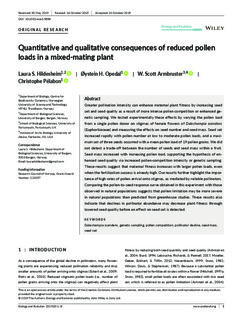| dc.contributor.author | Hildesheim, Laura | |
| dc.contributor.author | Opedal, Øystein Hjorthol | |
| dc.contributor.author | Armbruster, Scott | |
| dc.contributor.author | Pelabon, Christophe | |
| dc.date.accessioned | 2020-01-16T09:40:11Z | |
| dc.date.available | 2020-01-16T09:40:11Z | |
| dc.date.created | 2019-12-17T10:23:45Z | |
| dc.date.issued | 2019 | |
| dc.identifier.citation | Annals of Botany. 2019, 124 869-881. | nb_NO |
| dc.identifier.issn | 0305-7364 | |
| dc.identifier.uri | http://hdl.handle.net/11250/2636583 | |
| dc.description.abstract | Background and Aims
To predict the evolutionary consequences of pollinator declines, we need to understand the evolution of delayed autonomous self-pollination, which is expected to evolve as a mechanism of reproductive assurance when cross-pollination becomes unreliable. This involves estimating the costs of increased levels of selfing as well as those associated with floral senescence.
Methods
We studied the mechanisms and costs of delayed self-pollination in the mixed-mating vine Dalechampia scandens (Euphorbiaceae) by first assessing among-population variation in herkogamy and dichogamy, which together determine the rate and timing of autonomous self-pollination. We then tested whether floral longevity responds plastically to delayed pollination. Finally, we assessed the costs of delayed self-pollination in terms of seed number and size, explicitly separating inbreeding depression from effects of floral senescence.
Key Results
Herkogamy varied extensively, while variation in dichogamy was more limited. Unpollinated blossoms increased their longevity, but seed quantity and quality decreased with increasing delays in pollination, independently of inbreeding depression.
Conclusions
In D. scandens, earlier autonomous selfing is facilitated by reduced herkogamy rather than reduced protogyny, providing reproductive assurance while maintaining the possibility for outcrossing events. Effective early autonomous self-pollination may evolve under reduced cross-pollination reliability in response to costs associated with floral senescence. | nb_NO |
| dc.language.iso | eng | nb_NO |
| dc.publisher | Oxford University Press (OUP) | nb_NO |
| dc.rights | Navngivelse 4.0 Internasjonal | * |
| dc.rights.uri | http://creativecommons.org/licenses/by/4.0/deed.no | * |
| dc.title | Fitness costs of delayed pollination in a mixed-mating plant | nb_NO |
| dc.type | Journal article | nb_NO |
| dc.type | Peer reviewed | nb_NO |
| dc.description.version | acceptedVersion | nb_NO |
| dc.source.pagenumber | 869-881 | nb_NO |
| dc.source.volume | 124 | nb_NO |
| dc.source.journal | Annals of Botany | nb_NO |
| dc.identifier.doi | 10.1093/aob/mcz141 | |
| dc.identifier.cristin | 1761677 | |
| dc.description.localcode | This is an open access article under the terms of the Creative Commons Attribution License, which permits use, distribution and reproduction in any medium, provided the original work is properly cited. © 2019 The Authors. Ecology and Evolution published by John Wiley & Sons Ltd. | nb_NO |
| cristin.unitcode | 194,0,0,0 | |
| cristin.unitcode | 194,66,10,0 | |
| cristin.unitname | Norges teknisk-naturvitenskapelige universitet | |
| cristin.unitname | Institutt for biologi | |
| cristin.ispublished | true | |
| cristin.fulltext | postprint | |
| cristin.qualitycode | 1 | |

